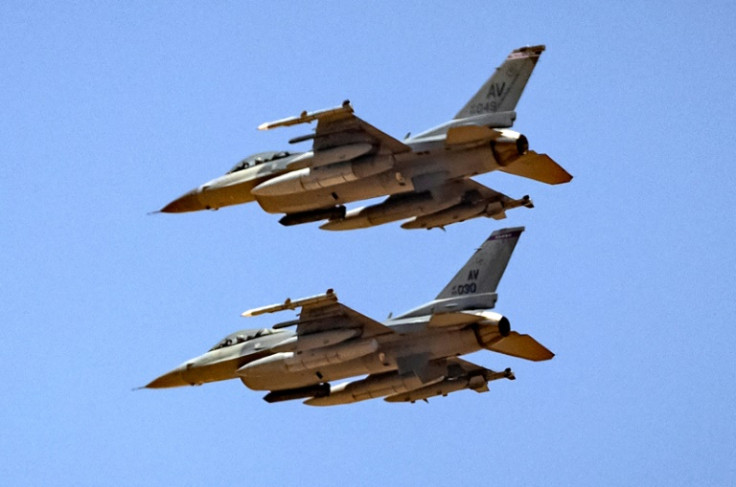After Tanks, Ukraine Allies Under Pressure To Send Warplanes

Western countries have only just approved sending battle tanks to Ukraine, but Kyiv is already requesting F-16 warplanes to help repel the Russian invasion.
While the United States has for now ruled that out, a few European nations appear more open to the idea.
US President Joe Biden on Monday appeared to draw the line on supplying American fighter jets to Kyiv.
"No," he said when asked by reporters at the White House if he was in favour, though the next day he said he would talk to his Ukrainian counterpart Volodymyr Zelensky about his latest requests for advanced weaponry.
In the early months of Russia's invasion of Ukraine, Kyiv's partners were reluctant to provide too much military aid, eager to avoid a more direct confrontation between the West and Russia.
But as the war grinds on, they have repeatedly given in to Ukraine's appeals for more substantial weapons.
In December, Washington finally agreed to send its high-performing Patriot air defence missiles. In January, it announced it would also be sending Abrams battle tanks.
After pressure from allies, Germany in January approved sending Leopard tanks to Kyiv -- and said it would agree to requests from other European countries who wanted to send their own German-made Leopards.
Ukrainian Defence Minister Oleksiy Reznikov said on Tuesday during a visit to France that his country was used to having its pleas for more equipment denied at first.
"For each initial request, we first have to fight against this 'no'. (But) it means 'no today'," he said.
"Let me remind you that, with the German Leopard tank, it was 'no' at first. But now we have a coalition of tanks."
Olivier Schmitt, a researcher at the Denmark-based Center for War Studies, said he did not think sending planes would escalate the conflict.
"Delivering fighter jets like the F-16s, which would allow Kyiv to wage an even more effective air-ground campaign, would not signal a symbolic breaking point or constitute an escalation," he wrote in the geopolitics journal "Le Grand Continent".
"This type of air-ground combat is typical of modern warfare".
But European capitals are undecided.
Germany, where the decision to send the Leopard tanks was seen as a major strategic turnaround, has ruled out sending warplanes.
Poland on Tuesday said it was not having "official discussions" on transferring any of its F-16s to Ukraine.
Britain appeared to rule out sending its combat planes.
"The UK's Typhoon and F-35 fighter jets are extremely sophisticated and take months to learn how to fly," the prime minister's official spokesman said.
"We believe it is not practical to send those jets into Ukraine."
France's President Emmanuel Macron said his country had not ruled out the delivery of fighter planes, but that Ukraine had not yet made such a request.
Others could be more eager to help.
Slovakia has said it would be prepared to send over MiG-29 fighter jets, while Dutch politicians recently floated the idea of sending Ukraine the F-16 jets it wants.
Olivier Fourt, a journalist specialised in military aircraft, said it was no surprise Kyiv had its heart set on that model.
"The F-16 is one the most produced fighter aircraft in the world, so there are lots of them, many European countries have some," he said. And "it's an excellent fighter jet".
But "in principle, in the United States, re-exportation rules are very strict."
Experts believe bolstering the Ukrainian air force could allow Kyiv to hit Russian troops deep in occupied territory and dissuade Russian bombers from hitting civilian and energy infrastructure in land it still controls.
But they warn the warplanes would not be a miracle solution to defeat the Russians.
"Western fighters will undoubtedly provide a major boost to Ukrainian air force survivability and air-to-air lethality" against the Russians, said Justin Bronk, a researcher at the UK-based RUSI think tank.
But "they would still be at risk from Russia's (surface-to-air missile) systems and have limited ground attack options," he wrote on Twitter.
And then there is the issue of the manpower to fly them.
"Ukrainian pilots will need to be found in order to be trained up" to fly the new planes, said retired NATO general Jean-Paul Palomeros.
"But how many are still operational today?" he asked.
Specialist site Oryx, which tracks destroyed aircraft, says Ukraine has lost more than 50 Soviet-era combat planes in less than a year since Russia invaded.
"You can't draw up an air force overnight," he said.
Long-range missiles, he suggested, might be equally as useful but easier to supply.
© Copyright AFP 2024. All rights reserved.




















